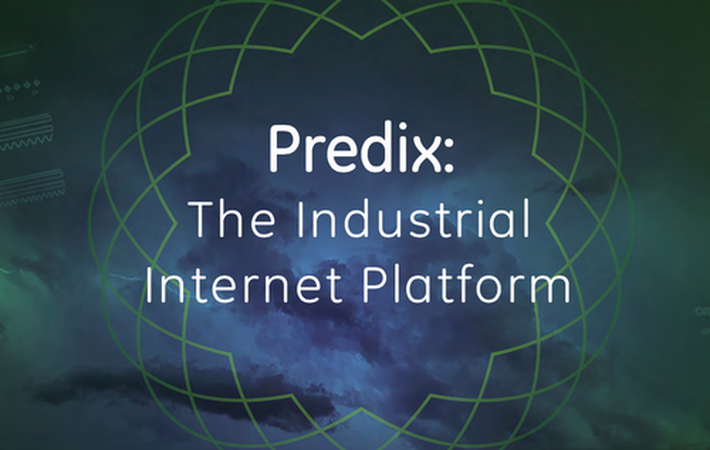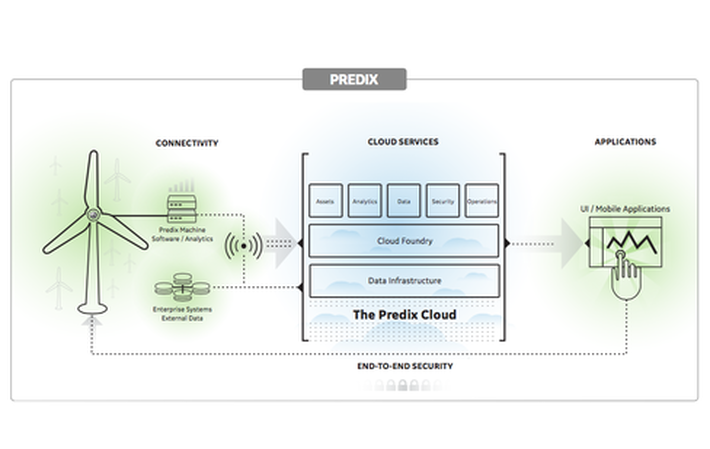
Published on 12/29/2016 | Technology
The capabilities summary below is excerpted from the Predix Platform Brief released by GE in February 2016 and from the Predix Webcast Presentation delivered by GE on May 10, 2016.
Why a platform? A platform offers a standardized way to enable an entire business to quickly take advantage of operational and business innovations. By using a platform that is designed around a reusable building block approach, developers can:
- build apps quickly.
- leverage work elsewhere.
- reduce sources of error.
- develop and share best practices.
- lower risk of cost and time overruns.
- future-proof their initial investments.
Independent third parties can also build apps and services on the platform, allowing businesses to extend capabilities easily by tapping the industrial ecosystem.
Why in the cloud? The cloud model allows businesses to take advantage of key capabilities including:
- economics of a centrally managed and shared infrastructure in a pay-as-you-go subscription model.
- scale to meet different business and application workloads by easily adjusting capacity on-demand.
- assets can be connected across the entire business so data can be captured.
- analytics can be developed and run to deliver insights at all levels of the organization.
A common cloud architecture also enables improved system governance, standardized security vulnerability assessments, and release management control and consistency.

Public cloud infrastructure doesn’t support the unique and demanding requirements of industry. For ex- ample, these clouds are developed to support IT data (such as ERP or CRM). Industrial data exists as multi- terabyte structured streams sampled continuously, resulting in unprecedented volumes of data (one plane flight, for example, can generate 1 TB of data). Also, how the cloud provider handles security incidents — especially the reporting and subsequent management and root causing — may impact operations.
As a leader in the industrial world, GE built a cloud that meets the needs industrial companies have for scale, security, and regulatory compliance. Predix cloud can handle vast amounts of Industrial Internet information, while also managing customer SLAs, security, support, governance, compliance, and export controls.
Gated industrial community
Predix is based on a multi-tenant “gated community” model to ensure that tenants of the cloud belong to the industrial ecosystem. This reduces the risk of bad actors entering the community, and enables GE to account for stringent regulatory requirements in ways that IT-focused public clouds cannot. Support for various data governance, federation, and privacy needs are included, as well as stringent security requirements, such as perimeter security, data security, access control, and data visibility.
Built on Cloud Foundry
Predix is built on Pivotal’s Cloud Foundry, an open source Platform-as-a-Service (PaaS). By using Cloud Foundry’s unique microservices architecture, its sup- port for existing languages and programming tools, together with its modern development and operations (DevOps) environment, app developers can quickly build, test, deploy, and, perhaps most importantly, scale applications in hours or days instead of weeks or months. Developers also gain access to the Cloud Foundry ecosystem and an ever-growing library of ser- vices that are continually being contributed by industry.
GE-managed cloud
GE will make Predix available to customers in the Americas, Europe, Africa, Middle East, and Asia. Data center locations are to be selected based on provider diversity, network peering, technology capabilities, regional data privacy considerations, customer needs, and security considerations. All locations will be ISO27002/01, SSAE16 SOC 2 compliant and operate at either Tier III (Concurrently Maintainable) or Tier IV (Fault Tolerance) levels, based on the Uptime Institute Standards.
Capacity on-demand
Predix uses software-defined infrastructure (SDI) as an abstraction layer above the hardware, allowing services to evolve over time, with minimal disruption to the applications. This SDI is especially useful when an application dictates that a change to the underlying hardware configuration is needed to ensure that demand is met. The provisioning management and pooling of resources can be done at a granular level, allowing for optimal resource allocation, and ultimately driving costs down and value up.
Enhanced security controls
Security is embedded at every level of the cloud stack. This specialized approach offers industrial-grade security, as every layer is monitored and scanned for vulnerabilities. Capabilities include encryption, key management, incident response services, logging, network-level security, support for end-to-end chain of custody reporting for code and data, and 24/7 security and network operations centers. See Appendix A for additional security details.
A truly global industrial platform needs to consume and analyze massive volumes of data by connecting to a wide variety of machines, sensors, control systems, data sources, and devices. Predix can securely connect with machines—old and new, GE and non-GE—on a very large scale. Once connected, data is captured, stored, analyzed, and made available to the right people at the right time to enable the right decisions.
Connecting GE and non-GE assets
The design and initial deployment of connectivity services can typically take 6-12 months. Predix connectivity services can provide same-day activation and provisioning. Combined with continual proactive monitoring support, troubleshooting, and automatic business alerts, these services deliver a managed, secure, end- to-end connectivity solution from the edge of a customer’s network to the Predix cloud.
Predix machine is part of the “edge” software for Predix. Its primary responsibility is to provide secure, bi-directional connectivity to industrial assets (GE or non-GE), while also enabling applications (analytical and operational services) at the edge. The latter is particularly important to delivering near-real-time processing in controlled environments. Predix machine can make any equipment or device a more intelligent “software defined machine,” enabling a new generation of smarter, more connected products.
Predix machine also provides security, authentication, and governance services for endpoint devices. This allows security profiles to be audited and managed centrally across devices, ensuring that assets are connected, controlled, and managed in a safe and secure manner, and that critical data is protected.
The Predix asset service enables developers to create, store, and manage asset models that define asset properties, as well as hierarchical relationships (parent, child, peer, etc.) between assets and other modeling elements. Asset models typically employ common elements. For example, classifications support different ways to identify and search for assets, which can provide a richer view of how the assets live within the business and who needs access. Templates can be used to create the structures that define the components that make up a complex asset.
One example use case is for configuration management. An application developer can create an asset model that describes the logical component structure of all locomotives in a fleet, and then create instances of that model to represent each individual locomotive. As a locomotive’s configuration changes over its lifespan, the changes are recorded in the system. This history then allows for a snapshot of that locomotive’s state (operating, retired, etc.) at a particular date and time. It also allows for displaying timelines of change events that have occurred to the asset over its lifespan.
Finally, Predix has an open asset model, which allows developers to create custom modeling objects that meet their own unique domain needs — for example, to support non-GE assets.
Building Industrial Internet apps comes with some unique requirements and needs that separate them from traditional IT apps. Typically developers spend up to 80% of their time integrating and upgrading systems and technologies, versus only 20% of time spent on innovation. GE has years of experience building software apps for industry, and the design of Predix incorporates those learnings with tools and services that decrease the amount of time spent on integration. In fact, the time spent on innovation is now closer to 80%.
Development teams are relieved from time consuming integration tasks, such as building software server stacks, integrating and configuring products, systems and ‘things’, managing SLAs (service level agreements), and scaling and securing infrastructure.
Microservices as building blocks
Predix microservices are reusable software modules that can be leveraged as building blocks to rapidly create applications. Because they are developed and delivered as discrete services, these microservices can be loosely coupled into apps without the complexity and dependencies of traditional, monolithic app architectures. Additionally, because microservices can be developed as separate, stand-alone components, developers can use their favorite language and tools. The microservices architecture provides a level of isolation, enabling small teams of developers to deliver new capabilities and to version existing services, such as Connectivity, Asset, Field Agent, and Time series, incrementally. Microservices are also great enablers for continuous delivery, allowing frequent releases for users while keeping the rest of the system available and stable. They are also easy to maintain, so once solutions are deployed, updates are much simpler and more efficient, eliminating code recompilation and streamlining operations. Apps and microservices built on Predix also benefit from the availability and scalability of the underlying infrastructure provided within GE’s own managed data centers.